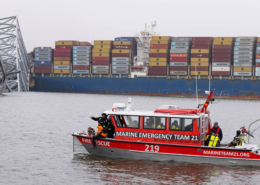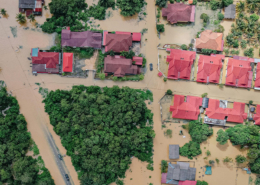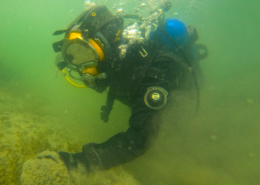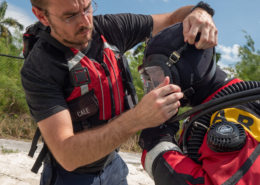After the Dive: The Decontamination Process
If you dive in contaminated water, and most public safety divers will, then you must be aware of the procedures to be followed for decontamination, i.e., the cleaning of the diver and his gear following a dive. As a dive team member, you will undoubtedly be called upon to make the dive, to decontaminate your team mates, and to run the dive. There are specific procedures to be followed no matter what your responsibilities are while conducting a contaminated water dive.
My first contaminated water dive took place while I was attending commercial diving school in Santa Barbara. Our task was to inspect the diffuser ports on a sewer outfall where the level of water treatment was minimal. At the time, I ‘m sure that none of the students or the faculty understood the serious nature of the dive, since we all made the dive in scuba gear. In retrospect, I am sure the dive was used as a test to wash out students who weren’t really serious about the program. Today, the school does not allow the students to dive inside the harbor after a heavy rain for fear of exposure to contaminants that have accumulated in the closed confines of the docks.
In actuality, most bodies of water have some level of contaminants in them, even when the water looks “clean.” A few years back, I was invited to lecture to the Canadian military in Toronto and the attitude of many of their divers was that there was nowhere that they went diving that was not contaminated.
In looking at the process of decontamination of divers in the field, I have consistently found that this is the area where most dive teams fall down on the job. The two areas where we see problems are 1) properly protecting the tender, and 2) properly decontaminating the diver. Probably the only reason we don’t hear more about issues here is that in most cases, divers are facing biological hazards that don’t cause death or permanent disability, but rather infections of the ears or short term intestinal infections. However, there are probably many lost work time cases that we just don’t hear about.
For example, the official U.S. Navy photo here shows a diver allegedly being decontaminated following a dive, yet the tenders who are working with him are completely unprotected. If you take a look at this video of a diver working inside a sewage treatment plant in Mexico City, notice the complete lack of decontamination of the diver and the failure to protect the tenders.
Equipment Decontamination
The decontamination of diving equipment can be problematic, depending on what it has been exposed to. Exposure to biological contamination is not normally a problem in most cases, but exposure to strong chemical agents can be a serious issue. Although they don’t like to admit it, most diving equipment manufacturers have not invested the money to test their gear against some of the more aggressive chemicals in the world to determine their chemical compatibility or what is an effective and safe solution to use for decontamination. This is understandable for several reasons. First, there are millions of chemical compounds in the world and it’s not financially feasible for diving equipment manufacturers to test their gear against them and determine acceptable decontaminants. Secondly, the manufacturers are very concerned about the liability issues surrounding decontamination, and with good reason.
Risks Present During Decontamination
If you’re scrupulous about how you decontaminate the diver, there are still risks that you face post-dive, including contamination of the diver and heat exhaustion or heat stroke. These issues can pose serious hazards for both the tender and the diver. Many years ago while I was filming a decontamination procedure one of our divers almost passed out due to heat stress.
Contamination occurs when divers or tenders are improperly protected, when the diver’s suit or gloves are compromised due to careless handling, or when insufficient attention is paid to the decontamination procedure. Even if you have all the right gear and materials to decontaminate the diver, if you’re sloppy about your technique, exposure can occur.
Preparation Up Front
By itself, a dive in contaminated water isn’t really much different from dives made under other circumstances. What truly sets this type of diving apart, however, is all of the prep work that goes into being ready for the decontamination following the dive. Some of the items you must think about before the dive include:
- What cleaning equipment will you need, including brushes, fluids, and showers?
- What will be the source of water you will use during decontamination?
- How are you going to capture and contain spent decontamination fluids?
- How are you going to contain diving equipment if it needs definitive decon (i.e, disassembly to get into all of the small parts)?
- How are you going to decontaminate the diver if his system is compromised during the course of the dive or during decontamination?
- How are you going to keep the diver cool during the decontamination process?
- What steps are you going to take to medically monitor the diver?
- What level of protection do you need to adequately protect the tenders who are handling the hose and decontaminating the diver? Protection must be appropriate and may be as simple as a Tyvek suit and a face shield, or as complex as an encapsulating suit and an SCBA.
- Do you have a plan for how to deal with a diver who passes out during the decontamination process?
- What support can you expect from your local haz-mat team? (Hint, if the answer is none and you have not trained extensively for this type of diving, maybe you shouldn’t be conducting the dive.)
- How are you going to control traffic at the site?
- How are you going to use the zone management system to set up your equipment, i.e., support zone, contamination reduction corridor, contamination reduction zone, and contamination control line.
- What direction is the wind from and will spray carried by the wind affect the support crew or other people on the site?
On Site Decontamination
If you have planned for your decontamination procedures, and prepared for any contingencies, then your decontamination process should go pretty smoothly. If you have not thought your operation through, and practiced it regularly, then you had best be prepared for a potential catastrophe.
Gross decontamination, i.e., a simple wash down, can start as the diver exits the water. Provided you’re dealing with nothing more than “minor” biological contamination, a rinse with fresh water is usually sufficient to start the process. From there, the diver can proceed to a bath or shower using chemicals to neutralize contaminants. It is essential to keep the diver moving and to keep him cool to avoid the dangers of heat exhaustion or heat stroke.
If the diver is wearing a diving helmet rather than a full-face mask, the weight of the helmet will be significant out of the water. Care must be taken to help the diver support this weight without injury. Extra care must be taken during the removal of the helmet to prevent damage to the diver’s neck.
In cases of decontamination after exposure to dangerous biological or chemical hazards, the greatest risk occurs when the diver must remove the mask or helmet. The interface between these two pieces of gear must be given special attention to ensure it is clean.
Of course, once the diver has removed all of his equipment, he will need to go through a definitive decontamination shower.
Not for the Faint of Heart
Making a contaminated water dive should be anticlimactic if you have followed all of the proper procedures up front and during the dive. Yes, it takes more time, money, equipment, and training, but it’s far better than having a team member suffer injury, sickness, or death. While we can never eliminate all of the risks from diving, especially diving in contaminated water, we can certainly reduce these risks with good preparation.
Photo-1 – © S. Barsky Decon July-2015 022
US Navy 050911-N-5345W-092 U.S. Navy Sailors assigned to Mobile Diving
Photo 2 – © S. Barsky Decon July-2015 023
Photo 3 – © S. Barsky Decon July-2015 024
Photo 4 – © S. Barsky Decon July-2015 025
Photo-5 – © S. Barsky Decon July-2015 026







 Photo By: Defense Visual Information Distribution Service
Photo By: Defense Visual Information Distribution Service


 Y. ZIN
Y. ZIN


Zanechat odpověď
Chcete se zapojit do diskuse?Neváhejte přispět!